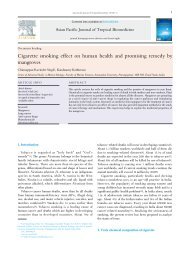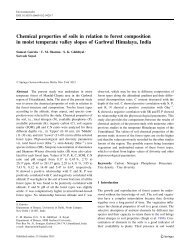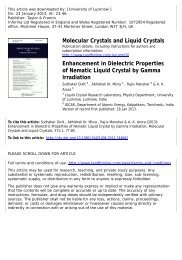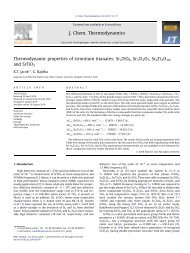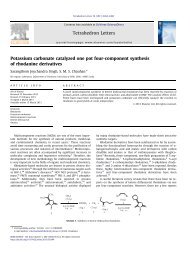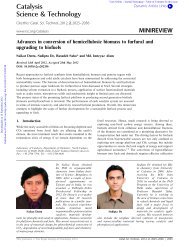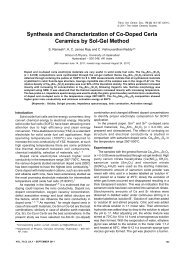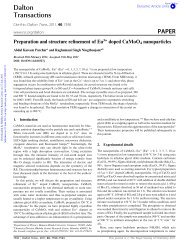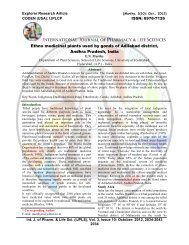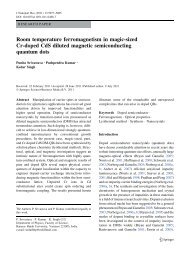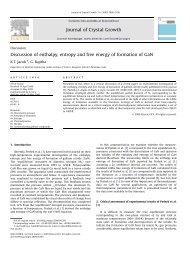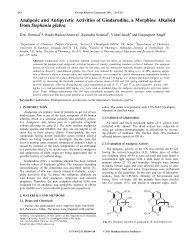Enhanced biodegradation and detoxification of disperse azo dye ...
Enhanced biodegradation and detoxification of disperse azo dye ...
Enhanced biodegradation and detoxification of disperse azo dye ...
Create successful ePaper yourself
Turn your PDF publications into a flip-book with our unique Google optimized e-Paper software.
102H.S. Lade et al. / International Biodeterioration & Biodegradation 72 (2012) 94e107synergistic effect <strong>of</strong> both cultures which supports their vigorousrole in the consortium. The role <strong>of</strong> oxidoreductive enzymes in thedecolorization <strong>of</strong> <strong>azo</strong> <strong>dye</strong> Reactive red 2 have been previouslycharacterized in Pseudomonas sp. SUK1 (Kalyani et al., 2009).Available literature on degradation <strong>of</strong> <strong>dye</strong>s shows that reductivecleavage <strong>of</strong> <strong>azo</strong> bond is the initial step in bacterial metabolism <strong>of</strong><strong>azo</strong> <strong>dye</strong>s under microaerophilic conditions. In our study, significantinduction <strong>of</strong> <strong>azo</strong> reductase (64%) <strong>and</strong> NADH-DCIP reductase (200%)activities in consortium-AP suggests their involvement in decolorization<strong>of</strong> <strong>dye</strong> molecule. No consequential change was seen inNADH-DCIP reductase activity <strong>of</strong> A. ochraceus NCIM-1146 culturecells after decolorization, while it was reduced to 65% in Pseudomonassp. SUK1 cells. Moreover, induction in <strong>azo</strong> reductase activityup to 36% was observed in individual Pseudomonas sp. SUK1 cellsafter decolorization, whereas it was absent in A. ochraceus NCIM-1146 cells (Table 3). In the same contest, the inductive pattern <strong>of</strong>reductase was reported during the decolorization <strong>of</strong> <strong>azo</strong> <strong>dye</strong> Navyblue HE2R by developed consortium-PA <strong>of</strong> A. ochraceus NCIM-1146fungi <strong>and</strong> Pseudomonas sp. SUK1 bacterium (Kadam et al., 2011).The reason why individual cultures alone cannot completelydegrade the <strong>dye</strong> molecule is not clear, but in the consortium it maybe due to the synergetic actions <strong>of</strong> oxidoreductases (Gou et al.,2009; Telke et al., 2009b).3.6. Biodegradation analysisHPTLC analysis <strong>of</strong> metabolites obtained after <strong>biodegradation</strong> <strong>of</strong><strong>dye</strong> Rubine GFL was carried out to provide an additional insight tothe biotransformation <strong>of</strong> <strong>dye</strong> molecule. The HPTLC chromatogramshowed the absence <strong>of</strong> control <strong>dye</strong> b<strong>and</strong> in the consortium-APmetabolites lane, which indicates its complete mineralization,whereas it was present in A. ochraceus NCIM-1146 <strong>and</strong> Pseudomonassp. SULK1 metabolites lanes indicates its partial degradation(Fig. 3a). Furthermore, the intensity <strong>of</strong> derivatized b<strong>and</strong>s <strong>of</strong> individualcultures metabolites was found to be decreased inconsortium-AP metabolites suggesting its further biotransformation.With respect to Rf values, control <strong>dye</strong> Rubine GFL showed twopeaks (0.84, 0.94), where as individual A. ochraceus NCIM-1146showed six peaks (0.13, 0.16, 0.38, 0.64, 0.84, 0.94), Pseudomonassp. SULK1 showed seven peaks (0.14, 0.42, 0.51, 0.55, 0.65, 0.84,0.94) <strong>and</strong> its consortium-AP showed seven distinct peaks (0.13,0.30, 0.42, 0.47, 0.56, 0.66, 0.93) indicates the differential degradationpattern <strong>of</strong> <strong>dye</strong> by individual cultures <strong>and</strong> its consortium-AP(Fig. 3b).HPLC analysis <strong>of</strong> the control <strong>dye</strong> Rubine GFL showed single peakat retention time <strong>of</strong> 2.971 min (Fig. 4a), while formed metaboliteafter decolorization by consortium-AP showed the disappearance<strong>of</strong> the major peak as seen in case <strong>of</strong> control <strong>dye</strong> Rubine GFL <strong>and</strong> theformation <strong>of</strong> two major peaks at retention time <strong>of</strong> 3.047 <strong>and</strong>3.317 min <strong>and</strong> three minor peaks at retention times <strong>of</strong>, 2.265, 4.123<strong>and</strong> 4.663 min (Fig. 4b), which were not seen in the control <strong>dye</strong>. Theappearance <strong>of</strong> five new peaks <strong>and</strong> disappearance <strong>of</strong> the single peakin the metabolites formed after decolorization by consortium-APsupport the more mineralization <strong>of</strong> parent <strong>dye</strong> Rubine GFL intodifferent metabolites. In case <strong>of</strong> individual cultures, decolorizedproduct <strong>of</strong> Rubine GFL by A. ochraceus NCIM-1146 showed twomajor peaks at retention times, 1.484 <strong>and</strong> 1.572 min (Fig. 4c), whileFig. 6. FTIR spectrum <strong>of</strong> control <strong>dye</strong> Rubine GFL [a] <strong>and</strong> its metabolites obtained afterdecolorization by using consortium-AP [b], A. ochraceus NCIM-1146 [c] <strong>and</strong> Pseudomonassp. SUK1 [d] after 30 h <strong>of</strong> incubation.Fig. 7. FTIR spectrum <strong>of</strong> textile effluent [a] <strong>and</strong> its metabolites obtained after decolorizationby using consortium-AP [b] after 35 h <strong>of</strong> incubation.
H.S. Lade et al. / International Biodeterioration & Biodegradation 72 (2012) 94e107 103Pseudomonas sp. SUK1 showed two major <strong>and</strong> two minor peaks atthe retention time <strong>of</strong> 2.106, 2.462, 2.858 <strong>and</strong> 3.001 min (Fig. 4d).This suggested the conversion <strong>of</strong> parent <strong>dye</strong> into various metabolitesby individual cultures.It is well known that textile industry consume large volume <strong>of</strong>water for various <strong>dye</strong>ing processes <strong>and</strong> thus releases large volumes<strong>of</strong> wastewater with numerous pollutants are discharged. Since theeffluent is a complex mixture <strong>of</strong> <strong>dye</strong>s, it showed different peakswhen characterized by HPLC. The HPLC chromatogram <strong>of</strong> the realtextile effluent showed the presence <strong>of</strong> four major peaks at retentiontimes <strong>of</strong> 3.199, 3.325, 4.122 <strong>and</strong> 5.098 min <strong>and</strong> four minorpeaks at retention times <strong>of</strong> 3.758, 4.706, 4.516 <strong>and</strong> 7.895 min(Fig. 5a). The degraded products <strong>of</strong> textile effluent by consortium-AP after 35 h <strong>of</strong> incubation showed the disappearance <strong>of</strong> severalTable 4GC-mass spectral data <strong>of</strong> metabolites obtained after degradation <strong>of</strong> Rubine GFL by A. ochraceus NCIM-1146 <strong>and</strong> Pseudomonas sp. SUK1.Retention time (min) m/z Mol. weight Name <strong>of</strong> metabolite Mass spectrumI] A. ochraceus NCIM-114619.356 244 241 1-(2-methyl-4-nitrophenyl)-2-phenyl diazene [I]13.029 166 165 (2-methyl-4-nitrophenyl)diazene [II]II] Pseudomonas sp. SUK115.339 256 257 4-[(2-methyl-4-nitrophenyl)diazenyl] phenol [I]14.132 154 152 2-methyl-4-nitroaniline [II]
104H.S. Lade et al. / International Biodeterioration & Biodegradation 72 (2012) 94e107peaks as seen in case <strong>of</strong> real textile effluent <strong>and</strong> the formation <strong>of</strong>three major peaks at retention times <strong>of</strong> 3.461, 3.553 <strong>and</strong> 3.774 min,while four new minor peaks at retention time <strong>of</strong> 3.223, 3.328, 4.125<strong>and</strong> 4.644 min (Fig. 5b). The difference in the retention times <strong>of</strong> realtextile effluent <strong>and</strong> metabolites formed after degradation byconsortium-AP confirms the <strong>biodegradation</strong> <strong>of</strong> effluent intodifferent metabolites.FTIR spectra obtained from control <strong>dye</strong> Rubine GFL showedspecific peaks at 779.766e910.90 cm 1 <strong>and</strong> 1173.17 cm 1 for CeHdeformation, 1202.15 cm 1 for CeN vibrations, 1341.18 cm 1 forNO 2 stretching <strong>of</strong> aromatic nitro compound, 1520.82 cm 1 for N]Ostretching <strong>of</strong> aromatic nitro compound, 1599.45 cm 1 for N]Nstretching in <strong>azo</strong> group, 2248.70 cm 1 for C^N stretching insaturated nitriles <strong>and</strong> 2926.58 cm 1 for CeH stretching in alkanes(Fig. 6a). After the consortium decolorization, a significant reductionin IR peaks was observed in the 2845.20 cm 1 to 2322.06 cm 1regions <strong>of</strong> metabolites suggests absence <strong>of</strong> charged amines in theproduced metabolites. A significant peak at 1659.73 cm 1 for NH þ 3deformation suggest the possible alkenes conjugation with C]O.Moreover, peaks at 992.89 cm 1 <strong>and</strong> 1151.77 cm 1 for CeH deformationsuggests cleavage <strong>of</strong> <strong>dye</strong> molecule. The absence <strong>of</strong> peak at1599.75 cm 1 for N]N stretching vibrations indicates the reductivecleavage <strong>of</strong> <strong>azo</strong> bond (Fig. 6b). Vanishing <strong>of</strong> major peaks <strong>and</strong>formation <strong>of</strong> new peaks in the IR spectrum <strong>of</strong> consortium-APmetabolites suggests the biotransformation <strong>of</strong> <strong>dye</strong> into distinctmetabolites.Metabolites obtained after partial decolorization <strong>of</strong> Rubine GFLby A. ochraceus NCIM-1146 showed peaks at 756.51 cm 1 to942.51 cm 1 <strong>and</strong> 1151.94 cm 1 for CeH deformations, 1384.28 cm 1for alkanes CH 3 deformation, 1456.49 cm 1 for alkanes CeHdeformation, 1531.93 cm 1 for N]O stretching <strong>and</strong> peaks at2872.33, 2926.58 <strong>and</strong> 2958.63 cm 1 for alkanes CeH stretching(Fig. 6c). Metabolites obtained after the partial decolorization <strong>of</strong>Rubine GFL by Pseudomonas sp. SUK1 showed peak at 810.76 cm 1for CeH deformation <strong>and</strong> 1333.90 cm 1 for formation <strong>of</strong> primaryaromatic amine which has also been additionally confirmed by GC-MS analysis. The peak at 1450.16 cm 1 represents alkanes CeHdeformation while that at 2849.08, 2917.59 <strong>and</strong> 2961.46 cm 1represents alkanes CeH stretching (Fig. 6d).Analysis <strong>of</strong> FTIR results <strong>of</strong> control textile effluent showedspecific peaks at 2925.65 cm 1 for alkanes CeH stretching,2862.31 cm 1 for alkanes CeH stretching, 1637.41 cm 1 for urea C]N stretching, 1458.04 cm 1 for alkanes CeH deformation,1400.72 cm 1 for phenols OeH deformation, 1261.09 cm 1 fornitrates OeNO 2 vibration, 1097.15 cm 1 for aliphatic ethersstretching, 805.60 cm 1 for benzene ring containing two adjacent Hatoms eCeH deformation <strong>and</strong> 601.68 cm 1 for alkynes CeHdeformation (Fig. 7a). Metabolites obtained after complete decolorization<strong>of</strong> effluent by consortium-AP showed disappearance <strong>of</strong>major peaks <strong>and</strong> formation <strong>of</strong> new peak at 2922.08 cm 1 foralkanes CeH stretching, 1650.88 cm 1 for acyclic C]N stretching,1461.65 cm 1 for alkanes CeH deformation, 1400.54 cm 1 forketones CeH deformation <strong>and</strong> 1109.02 cm 1 for secondary alcoholsCeOH stretching (Fig. 7b). Considerable difference between theFTIR spectrum <strong>of</strong> control textile effluent <strong>and</strong> the metabolitesobtained after complete decolorization by consortium-APconfirmed the <strong>biodegradation</strong> <strong>of</strong> effluent into different metabolites.GC-MS analyses <strong>of</strong> the metabolites raised from the degradation<strong>of</strong> <strong>dye</strong> Rubine GFL by A. ochraceus NCIM-1146 demonstrated theasymmetric cleavage <strong>of</strong> <strong>dye</strong> Rubine GFL mediated by veratrylalcohol enzyme to yields two metabolites, one <strong>of</strong> them is identifiedas 1-(2-methyl-4-nitrophenyl)-2-phenyl diazene (m/z ¼ 244).Further asymmetric cleavage <strong>of</strong> intermediate metabolite [I] byfungal laccase gave (2-methyl-4-nitrophenyl) diazene (m/z ¼ 166)[II] (Table 4; Fig. 8a). In Pseudomonas sp. SUK1 individual culture,the appearance <strong>of</strong> intermediate metabolite 4-[(2-methyl-4-nitrophenyl) diazenyl] phenol (m/z ¼ 256) [I] indicates the initialoxidative cleavage <strong>of</strong> parent <strong>dye</strong> Rubine GFL by bacterial laccase,Fig. 8. Proposed pathways for the degradation <strong>of</strong> Rubine GFL by A. ochraceus NCIM-1146 [a] Pseudomonas sp. SUK1 [b] <strong>and</strong> consortium-AP [c].
Table 5GC-MS spectral data <strong>of</strong> metabolites obtained after degradation <strong>of</strong> Rubine GFL by consortium-AP.Retention time (min) m/z Mol. weight Name <strong>of</strong> metabolite Mass spectrum18.964 284 284 N-ethyl-4-[(2-methyl-4-nitrophenyl)diazenyl] aniline [I]17.500 256 257 4-[(2-methyl-4-nitrophenyl)diazenyl] phenol [II]19.354 244 241 1-(2-methyl-4-nitrophenyl)-2-phenyldiazene [III]13.030 165 165 (2-methyl-4-nitrophenyl) diazene [IV]14.137 152 152 2-methyl-4-nitrophenol [V]
106H.S. Lade et al. / International Biodeterioration & Biodegradation 72 (2012) 94e107Table 6Phytotoxicity <strong>of</strong> Rubine GFL, textile effluent <strong>and</strong> its metabolites formed after degradation by consortium-AP for the S. vulgare <strong>and</strong> P. mungo.Parameters S. vulgare P. mungoGermination(%)Plumule(cm)Radicle(cm)DistilledwaterRubine GFLRubine GFLmetabolitesTextileeffluentEffluentmetabolitesDistilledwaterRubine GFLRubine GFLmetabolitesTextileeffluent100 50 100 40 100 100 60 100 50 100Effluentmetabolites4.99 0.77 1.95* 0.29 4.45 $ 0.55 1.60* 0.32 4.15 0.38 7.88 0.54 4.55* 0.16 6.80 $ 0.55 4.10* 0.13 6.65 $ 0.422.29 0.39 0.86** 0.07 2.25 $ 0.28 0.63* 0.09 1.65 $ 0.28 1.52 0.26 0.95* 0.09 1.40 $ 0.08 0.70* 0.07 1.30 $$ 0.06Values are mean <strong>of</strong> three experiments, SEM (). Seeds germinated in Rubine GFL <strong>and</strong> textile effluent are significantly different from the seeds germinated in distilled water at*P < 0.05, **P < 0.001 <strong>and</strong> the seeds germinated in metabolites are significantly different from the seeds germinated in Rubine GFL <strong>and</strong> textile effluent at $ P < 0.05, $$ P < 0.001by one-way analysis <strong>of</strong> variance (ANOVA) with TukeyeKramer comparison test.which was further cleaved at <strong>azo</strong> position by <strong>azo</strong> reductase to gave2-methyl-4-nitroaniline (m/z ¼ 154) [II] as identified aromaticamine (Table 4; Fig. 8b). This is in agreement with a previous reportwhich supports the involvement <strong>of</strong> bacterial reductases in thereductive cleavage <strong>of</strong> <strong>azo</strong> <strong>dye</strong>s to yield aromatic amines (Levine,1991). In addition, with the cleavage <strong>of</strong> <strong>azo</strong> bonds by bacterial <strong>azo</strong>reductase, most <strong>azo</strong> <strong>dye</strong>s get reduced microaerophilically to thecorresponding amines (Zimmerman et al., 1982). Pseudomonas sp.SUK1 laccase is known for oxidative as well as asymmetric cleavage<strong>of</strong> <strong>dye</strong> molecules, where as reductase is known for reductivecleavage <strong>of</strong> <strong>azo</strong> <strong>dye</strong>s (Kalyani et al., 2009; Kadam et al., 2011).In case <strong>of</strong> consortium-AP, enzymes from both bacteria <strong>and</strong> fungifacilitates <strong>dye</strong> metabolism, as there was significant induction inveratryl alcohol activity which results in asymmetric cleavage <strong>of</strong>parent <strong>dye</strong> molecule to form an intermediate N-ethyl-4-[(2-methyl-4-nitrophenyl) diazenyl] aniline (m/z ¼ 284) [I] (Table 5).It is reported that veratryl alcohol oxidase brings about the asymmetriccleavage <strong>of</strong> <strong>azo</strong> <strong>dye</strong>s (Jadhav et al., 2009). Further oxidativecleavage <strong>of</strong> intermediate [I] by laccase gives 4-[(2-methyl-4-nitrophenyl) diazenyl] phenol (m/z ¼ 256) [II], which undergoesdehydroxylation to form 1-(2-methyl-4-nitrophenyl)-2-phenyldiazene (m/z ¼ 244) [III]. Furthermore, asymmetric cleavage <strong>of</strong>intermediate [III] by veratryl alcohol enzyme leads to the formation<strong>of</strong> (2-methyl-4-nitrophenyl) diazene (m/z ¼ 165) [IV], whichundergoes <strong>azo</strong> bond cleavage by <strong>azo</strong> reductase to form 2-methyl 4-nitroaniline as unidentified aromatic amine. The earlier reportconfirms the role <strong>of</strong> <strong>azo</strong> reductase in direct cleaves <strong>of</strong> <strong>azo</strong> bond(Chen et al., 2003). This aromatic amine further get deaminated <strong>and</strong>oxidised by laccase to gave 2-methyl-4-nitrophenol (m/z ¼ 152) [V]as final metabolite (Table 5; Fig. 8c). The ability <strong>of</strong> consortium-AP tocompletely decolorize the <strong>dye</strong> without forming aromatic aminessuggested its applicability over individual cultures. The intermediatesnot detected by GC-MS but rationalized as necessary intermediatesduring the degradation process were labeledalphabetically.3.7. Toxicity studiesThe assessment <strong>of</strong> toxicity <strong>of</strong> <strong>dye</strong>s, effluents <strong>and</strong> its degradedproducts is <strong>of</strong>ten great concern as most <strong>of</strong> them exert toxic effect onplants <strong>and</strong> animals when released in stream water. Use <strong>of</strong> bioassayssuch as phytotoxicity for monitoring the toxic effect <strong>of</strong> <strong>dye</strong>s as wellas its metabolites on plants was suggested by many researchers(Valerio et al., 2007; Jadhav et al., 2011). Plant bioassays have beenused to establish the toxicity levels <strong>of</strong> <strong>dye</strong>, effluent <strong>and</strong> its degradedproducts on common agricultural crops. In this case, the phytotoxicitystudy revealed that there is an inhibition <strong>of</strong> germination insolutions containing 1000 ppm <strong>of</strong> the <strong>dye</strong> Rubine GFL for bothS. vulgare <strong>and</strong> P. mungo by 50 <strong>and</strong> 40% respectively (Table 6).Moreover the inhibition <strong>of</strong> germination in real textile effluent forS. vulgare <strong>and</strong> P. mungo was 60 <strong>and</strong> 50% respectively (Table 6). Onthe other h<strong>and</strong>, complete germination (100%) as well as significantgrowth in the plumule <strong>and</strong> radical was observed for both the plantsgrown in consortium-AP metabolites as compared to that <strong>of</strong> <strong>dye</strong><strong>and</strong> effluent (Table 6). In addition to this, the length <strong>of</strong> plumule <strong>and</strong>radicle was found to be lower in seeds germinated with <strong>dye</strong> <strong>and</strong>effluent samples than those germinated in distilled water as well as<strong>dye</strong> <strong>and</strong> effluent metabolites. This study suggest that the <strong>dye</strong> <strong>and</strong>effluent was toxic to these plants, while the metabolites formedafter consortium degradation was less toxic, which signifies the<strong>detoxification</strong> <strong>of</strong> <strong>dye</strong> <strong>and</strong> effluent by consortium-AP. These resultsunderline the importance <strong>of</strong> fungal-bacterium synergism forbioremediation <strong>of</strong> textile effluent in terms <strong>of</strong> both decolorization<strong>and</strong> <strong>detoxification</strong>.4. ConclusionsA new <strong>biodegradation</strong> approach with fungal-bacterial synergismwas first applied for degradation <strong>of</strong> <strong>disperse</strong> <strong>azo</strong> <strong>dye</strong> RubineGFL <strong>and</strong> textile effluent in submerged conditions. Overall studiesrevealed that the combined metabolic activities <strong>of</strong> A. ochraceusNCIM-1146 <strong>and</strong> Pseudomonas sp. SUK1 in the consortium led tocomplete decolorization <strong>and</strong> <strong>detoxification</strong> <strong>of</strong> <strong>dye</strong> <strong>and</strong> effluent. Incontrast, individual cultures showed lesser decolorization rate withthe formation <strong>of</strong> toxicants. The enhanced decolorization efficiency<strong>of</strong> consortium-AP could be due to the induced synergetic reactions<strong>of</strong> oxidoreductases viz. laccase, veratryl alcohol oxidase, <strong>azo</strong>reductase <strong>and</strong> NADH-DCIP reductase. Deep insight into thedifferent aspects presented here strongly supports its applicabilityfor enhanced <strong>biodegradation</strong> <strong>and</strong> <strong>detoxification</strong> <strong>of</strong> <strong>azo</strong> <strong>dye</strong>s whichare recalcitrant to degradation by individual cultures. With a betterunderst<strong>and</strong>ing, this fungal-bacterium synergism would be furtherexploited to develop a continuous treatment process for degradation<strong>and</strong> <strong>detoxification</strong> <strong>of</strong> textile effluent containing wide range <strong>of</strong><strong>azo</strong> <strong>dye</strong>s.AcknowledgementsThe author Dr. Harshad S. Lade would like to acknowledgeUniversity Grant Commission, New Delhi, India for providing Dr.D.S. Kothari Postdoctoral Fellowship.ReferencesAPHA, 1998. St<strong>and</strong>ard Method for the Examination <strong>of</strong> Water <strong>and</strong> Wastewater,twentieth ed. American Public Health Association, Washington, DC, USA. 2120E.Aust, S.D., 1990. Degradation <strong>of</strong> environmental pollutants by Phanerochaete chrysosporium.Microbial Ecology 20, 197e209.Banat, I., Nigam, P., Singh, D., Marchant, R., 1996. Microbial decolorization <strong>of</strong> textile<strong>dye</strong>containing effluents: a review. Bioresource Technology 58, 217e227.



